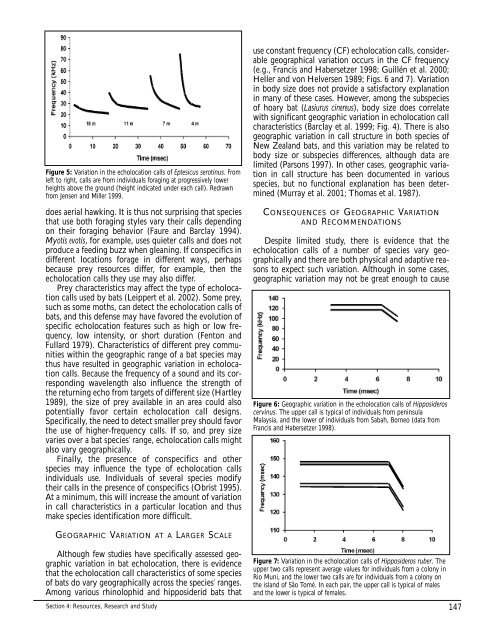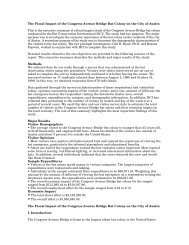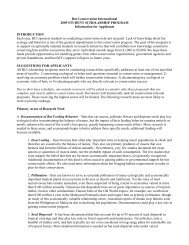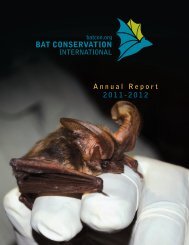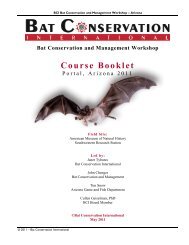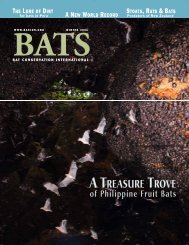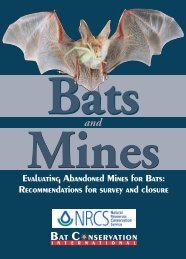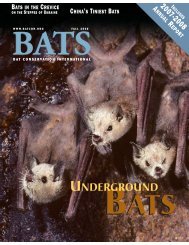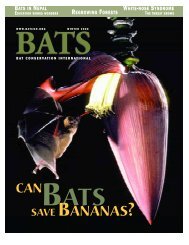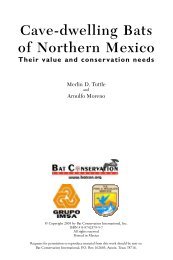Bat Echolocation Researc h - Bat Conservation International
Bat Echolocation Researc h - Bat Conservation International
Bat Echolocation Researc h - Bat Conservation International
You also want an ePaper? Increase the reach of your titles
YUMPU automatically turns print PDFs into web optimized ePapers that Google loves.
Figure 5: Variation in the echolocation calls of Eptesicus serotinus. From<br />
left to right, calls are from individuals foraging at progressively lower<br />
heights above the ground (height indicated under each call). Redrawn<br />
from Jensen and Miller 1999.<br />
does aerial hawking. It is thus not surprising that species<br />
that use both foraging styles vary their calls depending<br />
on their foraging behavior (Faure and Barclay 1994).<br />
Myotis evotis, for example, uses quieter calls and does not<br />
produce a feeding buzz when gleaning. If conspecifics in<br />
different locations forage in different ways, perhaps<br />
because prey resources differ, for example, then the<br />
echolocation calls they use may also differ.<br />
Prey characteristics may affect the type of echolocation<br />
calls used by bats (Leippert et al. 2002). Some prey,<br />
such as some moths, can detect the echolocation calls of<br />
bats, and this defense may have favored the evolution of<br />
specific echolocation features such as high or low frequency,<br />
low intensity, or short duration (Fenton and<br />
Fullard 1979). Characteristics of different prey communities<br />
within the geographic range of a bat species may<br />
thus have resulted in geographic variation in echolocation<br />
calls. Because the frequency of a sound and its corresponding<br />
wavelength also influence the strength of<br />
the returning echo from targets of different size (Hartley<br />
1989), the size of prey available in an area could also<br />
potentially favor certain echolocation call designs.<br />
Specifically, the need to detect smaller prey should favor<br />
the use of higher-frequency calls. If so, and prey size<br />
varies over a bat species’ range, echolocation calls might<br />
also vary geographically.<br />
Finally, the presence of conspecifics and other<br />
species may influence the type of echolocation calls<br />
individuals use. Individuals of several species modify<br />
their calls in the presence of conspecifics (Obrist 1995).<br />
At a minimum, this will increase the amount of variation<br />
in call characteristics in a particular location and thus<br />
make species identification more difficult.<br />
use constant frequency (CF) echolocation calls, considerable<br />
geographical variation occurs in the CF frequency<br />
(e.g., Francis and Habersetzer 1998; Guillén et al. 2000;<br />
Heller and von Helversen 1989; Figs. 6 and 7). Variation<br />
in body size does not provide a satisfactory explanation<br />
in many of these cases. However, among the subspecies<br />
of hoary bat (Lasiurus cinereus), body size does correlate<br />
with significant geographic variation in echolocation call<br />
characteristics (Barclay et al. 1999; Fig. 4). There is also<br />
geographic variation in call structure in both species of<br />
New Zealand bats, and this variation may be related to<br />
body size or subspecies differences, although data are<br />
limited (Parsons 1997). In other cases, geographic variation<br />
in call structure has been documented in various<br />
species, but no functional explanation has been determined<br />
(Murray et al. 2001; Thomas et al. 1987).<br />
CONSEQUENCES OF GEOGRAPHIC VARIATION<br />
AND RECOMMENDATIONS<br />
Despite limited study, there is evidence that the<br />
echolocation calls of a number of species vary geographically<br />
and there are both physical and adaptive reasons<br />
to expect such variation. Although in some cases,<br />
geographic variation may not be great enough to cause<br />
Figure 6: Geographic variation in the echolocation calls of Hipposideros<br />
cervinus. The upper call is typical of individuals from peninsula<br />
Malaysia, and the lower of individuals from Sabah, Borneo (data from<br />
Francis and Habersetzer 1998).<br />
GEOGRAPHIC VARIATION AT A LARGER SCALE<br />
Although few studies have specifically assessed geographic<br />
variation in bat echolocation, there is evidence<br />
that the echolocation call characteristics of some species<br />
of bats do vary geographically across the species’ ranges.<br />
Among various rhinolophid and hipposiderid bats that<br />
Section 4: Resources, <strong>Researc</strong>h and Study<br />
Figure 7: Variation in the echolocation calls of Hipposideros ruber. The<br />
upper two calls represent average values for individuals from a colony in<br />
Rio Muni, and the lower two calls are for individuals from a colony on<br />
the island of São Tomé. In each pair, the upper call is typical of males<br />
and the lower is typical of females.<br />
147


